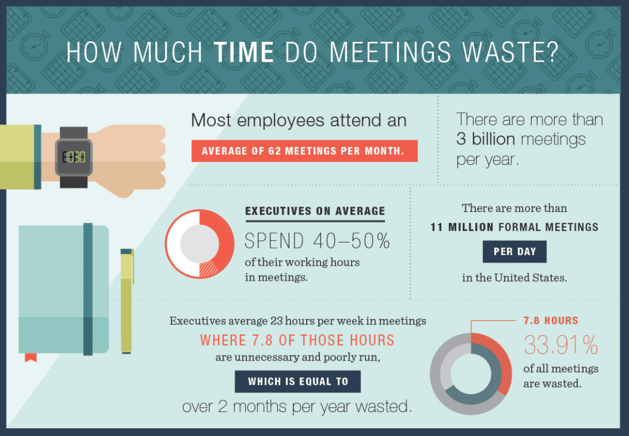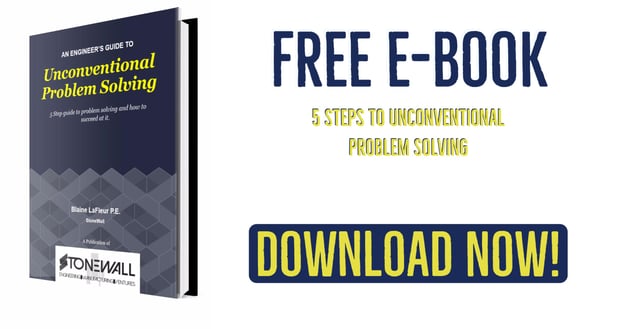
Sometimes, when I sit in meetings, especially ones in which people don’t seem engaged, I calculate the cost in staff time. I’ve estimated that one standard weekly meeting in my engineering firm — 5 people sitting in a cookie-cutter conference room, looking both bored and anxious — costs around $77,000 annually, and surely this scenario occurs throughout the organization hundreds of times a month. It drains us, and it breeds cynicism. So many meetings are lost opportunities.
Do these sentiments sound familiar to you? They should, according to these statistics on meetings:
- Organizations hold more than 3 billion meetings each year.
- Executives spend 40-50% of their working hours — or 23 hours per week — in meetings.
- 90% of meeting attendees admit to daydreaming in them.
- 73% acknowledge they do other work during meetings.
- 25% of meetings are spent discussing irrelevant issues.

At the same time, the right kind of meetings can be key to advancing a team or organization’s agenda. So how do you ensure that the gatherings you host are productive, not destructive?
By applying design thinking, a concept popularized by IDEO founder David Kelly and Stanford’s d.school, which was first applied to the design of physical objects, then other products, such as engineered tools, and now to more complex challenges across a wide variety of industries. The idea is to put the “user” at the center of the experience — an approach that works with meeting design, too.
Start by putting your own expertise and agenda aside and thinking about the people who will be affected by your meeting. Develop empathy for them by asking three sets of questions:
- Who is going to be in the room and what are their needs?
- Who won’t be in the room but will nevertheless be affected by the meeting and what are their needs?
- In what broader culture and environment are you operating and what are some of the overarching challenges and opportunities?
Actively seek out individuals who will attend the meeting, or who will be affected by it, and speak with them — ideally in person. Even if you run regular meetings with the same group of people, these individual brief check-ins can help build trust, surfaces hidden issues and ensures that participants feel more invested.
Next, set a frame for the meeting. Once you’ve attentively listened and observed, you’ll want to suggest an overarching purpose for the meeting and articulate clear outcomes that will connect to achieving it. A question that you should ask yourself is: If this meeting is extremely successful, what will people feel, know, and do as a result? Include these desired outcomes/accomplishments in your agenda, so that participants know why they’re attending and can gauge with you whether or not the time has been productive.
In other words, what will this meeting accomplish? Use the accomplishments as focal points to lead your meeting. In our experience, people rarely spend enough time doing these things. Meetings are often put on the calendar without a particular accomplishment in mind — simply to hold the time — and, as a result, the cart often drives the horse; people meet simply because they feel they must. Even short meetings deserve a clear purpose and clearly articulated desired outcomes. This keeps people on task, and ensures that people feel that their time is well spent.
The third step is to creatively design the meeting. Once you know the core question to address, and what success might look like, you should create your agenda. People tend to throw agendas together at the last minute, if at all. The design and execution of meetings should be compared to the driving navigation app Waze: what is the quickest, safest, most effective way to get to your destination? The first step, immersing yourself with people, was about understanding where you need to go (the beach? the city? the mountains?). The second step was about identifying your desired destination — your exact address and location. This third step is all about the route. Should you get there as fast as possible? Do you need to take a detour? What is the most scenic route? Are there roads that you’ve traveled so many times before that are perhaps best to avoid? What might you need to watch out for — your team’s equivalent of potholes or traffic jams? This is the phase where we encourage people to be creative, to put reality on hold for a bit and push past their initial, “go-to” ideas. What would it look like for you to infuse your meetings with a bit of excitement? To begin and end in an unexpected way? To use film, images, poetry, or music to spark ideas? To create an opportunity for personal sharing and connection? While this might sound frivolous, it is actually extremely important. Meetings are opportunities not simply to get things done, but also foster a positive team culture.
Finally, test-drive your plan, in the same way that an engineering designer would put an early prototype into users’ hands. In a meeting context, this might be a draft agenda shared with participants. Their responses will help you gain more empathy, frame new questions, get even more creative in your meeting design, and increase your potential for success at the actual gathering.
People who have applied this design process to their meetings tell us that it has radically affected both the efficacy of those gatherings, and the attitude people in their organizations have about them. Each phase has its benefits. Immersing helps people feel heard, and it ensures that meeting leaders are connected to participants. Framing pushes the meeting leaders to ensure that there are clear goals for each meeting. Imagining leads to more creativity and experimentation in the meeting design. Finally, prototyping—something as simple as getting feedback on your plan from a few people — makes people feel valued, more accountable in the meetings, and more invested in their success.
This may seem onerous for every meeting but, with practice, you can learn to cycle through these stages in less and less time, and you’ll find that small investment upfront saves significant time in the long run. You’ll have fewer meetings, and those you do have will be more productive — even sometimes fun.




.jpg?width=629&height=329&name=Adobe%20Spark%20(82).jpg)

